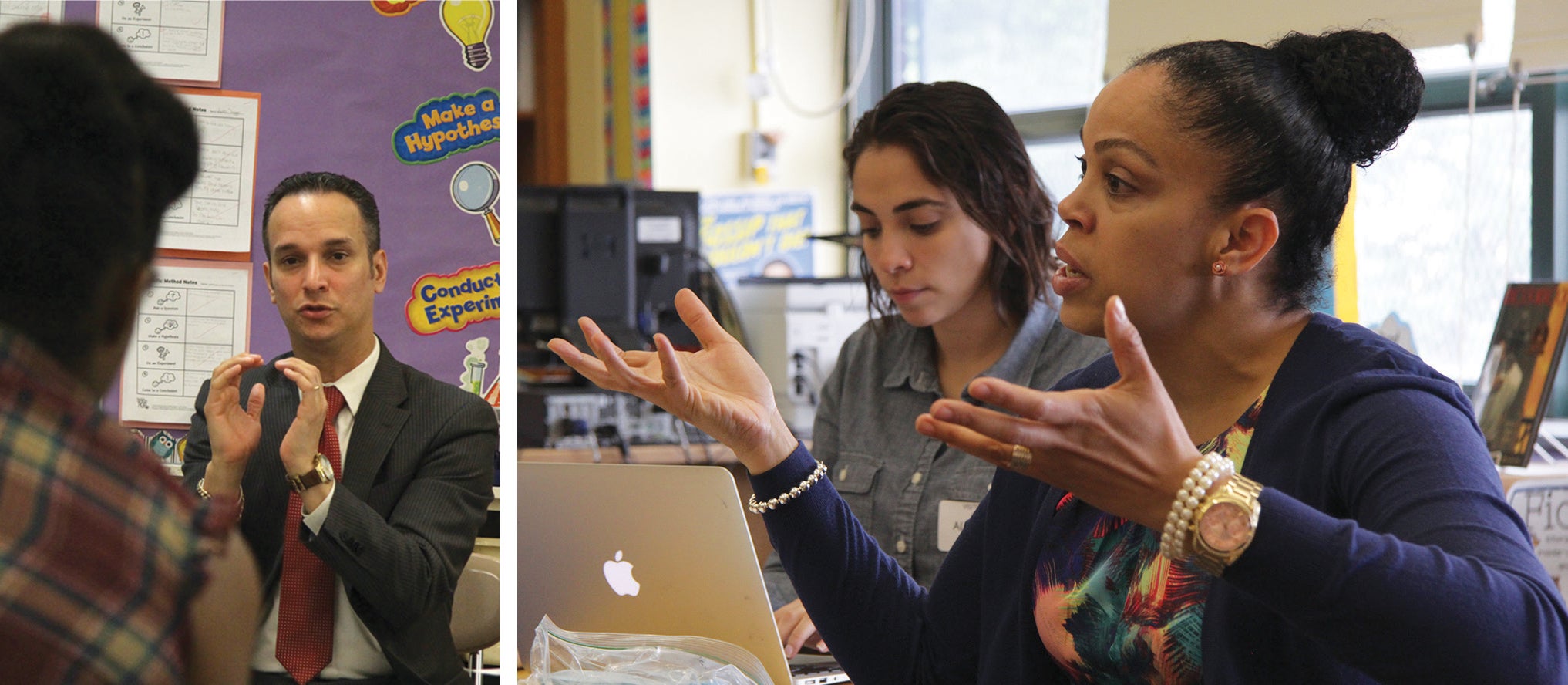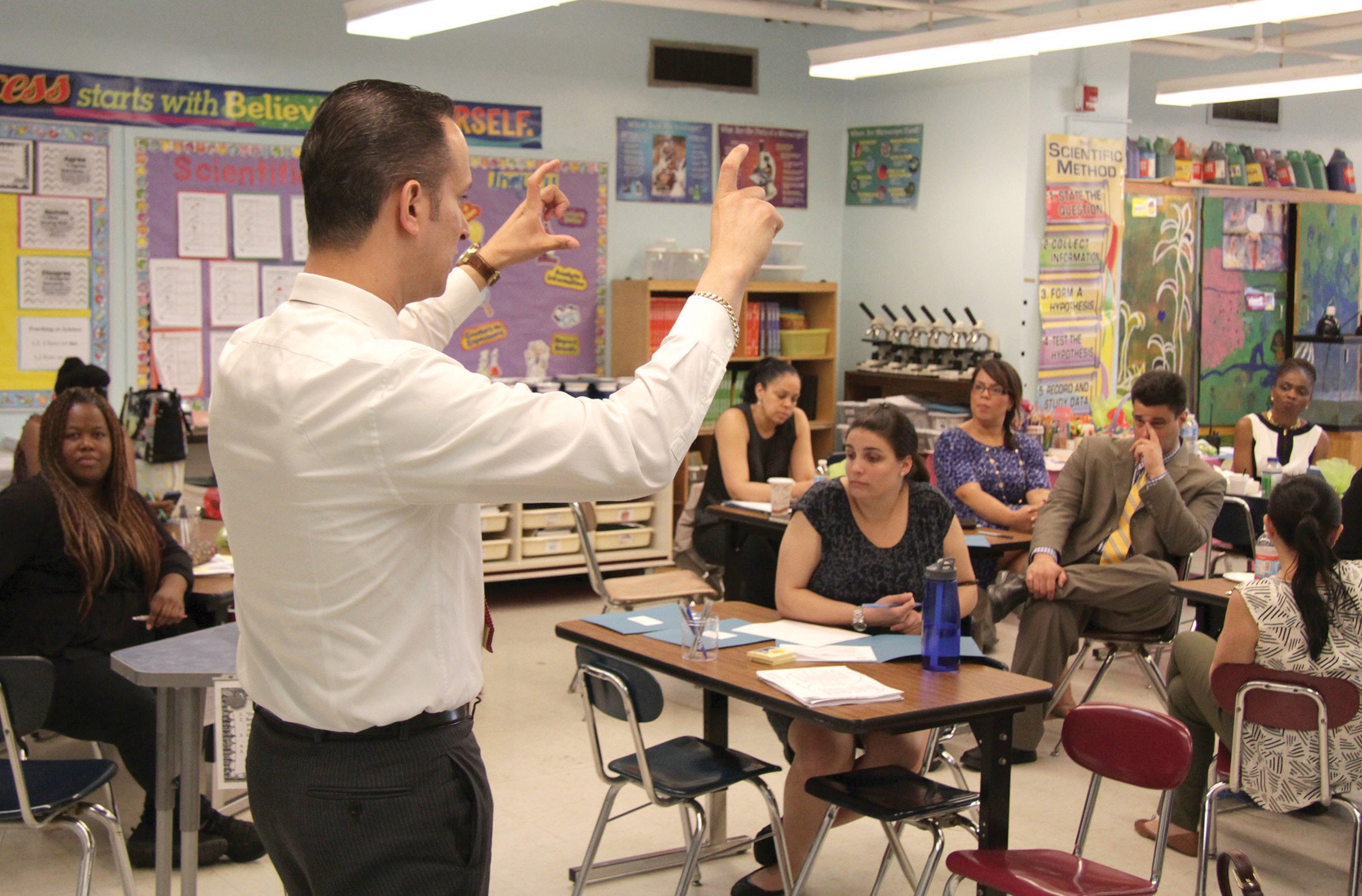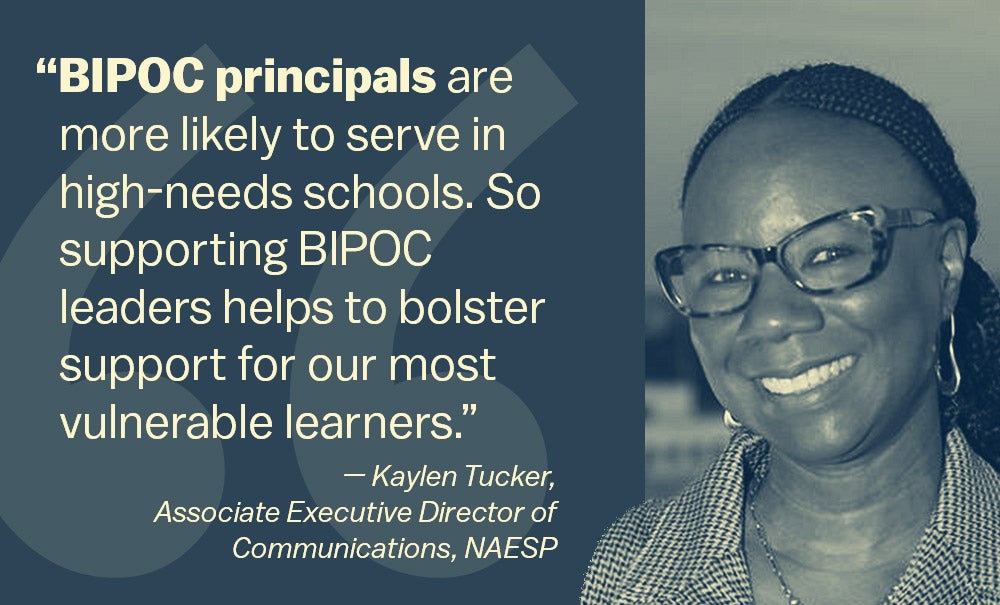Summary
This article profiles the Learning Partners Program, a novel effort in New York City that matches veteran principals with two or more newer ones in order to build the skills of emerging school leaders. It describes the program at the end of its first year, detailing how groups of schools stay in touch, observe each others’ work, chew over problems and come up with solutions. It also highlights the supports that the district provides for each group of schools, including skilled facilitators who plan group meetings, structure conversations among schools, connect principals to city resources and help them carry out improvement strategies they develop as a group. The article was published in the October 2015 issue of JSD, a professional-learning journal for educators.
Principal Josette Claudio of P.S. 109 in the Bronx faced a problem. More than a third of her teachers had quit over one summer, possibly, according to surveys, because they were dissatisfied with the discipline in the school.
Claudio had programs in place to encourage good behavior so teachers could concentrate on classroom instruction, but some had not taken hold. For example, her “Claudio Cash” program, which rewards well-behaved students with tokens they can redeem for pencils, books, or other trinkets from a Claudio Cash store set up in the building, was faltering because several staff members didn’t see it as a priority and wouldn’t show up to staff the store. As a result, rewards students had been promised would languish behind locked doors, frustrating children who had spent weeks or months collecting the tokens.

Confronted with this kind of problem — or any of the other myriad difficulties that arise in the life of a leader trying to improve teaching and learning in school — many principals would have to struggle through on their own. However, this past school year, Claudio was fortunate to have an expert to help her through: David Cintron, eightyear principal of P.S. 214. Sure enough, he had a suggestion that was as simple as it was commonsensical. Why not put the “store” on a cart and let the people who support the program take it from classroom to classroom?
That Claudio had an experienced hand she could turn to was not serendipitous. Rather, it was the result of a novel effort in New York City: the Learning Partners Program, which matches veteran principals with two or more newer ones. In 2014-15, the first full year of the effort, the city’s Department of Education put 73 of the city’s more than 1,800 schools into 23 groups of threes and one group of four. Every group comprised one host school and at least two partner schools. The hosts each had muscle in one or more of 16 focus areas that the city identified as crucial to improving education; the partner schools had to be seeking to improve in those areas. In Cintron’s case, the other partner school was P.S. 143 in Queens, led by Jerry Brito, who, like Claudio, was a third-year principal.
The idea originated with New York City’s top education official, Carmen Fariña, who had spent a number of years as a principal. After becoming schools chancellor in 2014, Fariña said in a video for The Wallace Foundation, she drew on that early experience, specifically the recollection that “the way I learned best as a new principal was by learning from more experienced principals.” The Learning Partners Program seeks to replicate that in a way that encourages uninhibited exchange among peers. “No one’s rating these visits. No one’s saying, ‘You have to do it exactly this way,’ ” Fariña said. “It’s about engaging people in open conversations about how to get better in leadership.”
A key aspect of the effort is that a number of school staff members — not just principals, but assistant principals and teacher leaders, too — are involved. That means the program can enhance the skills of current principals while grooming the next generation as well. Through Learning Partners, participants stayed in touch throughout the year, meeting as a group for daylong sessions once a month to observe each other’s work, chew over problems, and come up with solutions. Each school took turns hosting these monthly meetings so the entire group could watch its staff at work and offer suggestions for improvement.
Another key facet of the program is that the 16 focus areas cover the gamut of what good principals should master, from developing teachers, to supporting struggling students, to using resources strategically, to promoting family engagement. “All of these things relate to each other,” said Marina Cofield, the Department of Education’s senior executive director for leadership. “At the end of the day, all of the work supports teaching and learning.”
Staffers from the partner schools benefit from watching skilled hands at work. And staffers from host schools benefit from a stipend: an extra $15,000 for the year for host principals, $10,000 for assistant principals, and $7,500 for teachers who participate. Part of the funding for the program comes from The Wallace Foundation, a national philanthropy that supports efforts to develop effective school leadership.
"The Answer in the Room"
The city’s Office of Interschool Collaborative Learning, which manages the program, sifted through about 200 applications to select the 73 schools that participated in the 2014-15 school year. Host schools needed not only success in one or more of the city’s focus areas, but they also had to be led by principals with at least five years in a leadership role in New York City and must admit at least part of their student population without regard to students’ prior attendance or academic records.
Partner schools had to have principals with between two and four years’ experience running a New York City school, a high-needs student population, and well-defined focus areas in which they wanted to improve. Principals also had to demonstrate their ability to participate in the program without compromising the quality of education. Schools struggling at the most basic level, too overwhelmed to commit time to the program, are directed to other, more appropriate forms of assistance. In addition, all schools had to demonstrate support from their leadership teams and other key staffers.
Cintron’s school, in the West Farms area of the Bronx, was selected as a host in part because of its success in two of the city’s focus areas: building teacher and assistant principal leadership and aiding students’ social and emotional development. Both Josette Claudio and Jerry Brito sought to improve in these focus areas.
Brito’s interest in improving his school’s leadership systems stemmed in large part from his desire to ensure the sound management of a flurry of changes, including implementation of the Common Core State Standards and the state’s new teacher evaluation system. Brito runs one of the city’s largest elementary schools — P.S. 143 has nearly 1,800 students and 103 teachers — and he didn’t think he could navigate the changes without building support for the new policies and delegating responsibility to key staffers. “It was going to be a tsunami of changes happening at one time,” he said. “There are too many moving parts. Trying to push something on my own without people believing in it just wasn’t going to work.”
Throughout the year, he and teams from his school met with Claudio, Cintron, and teams from their schools. His team members would talk over challenges they faced, get advice from the other schools, and observe their teams at work. After each period of observation, they had time to ask questions about how they could put some of the practices they saw in place in their school.
Challenges remain after the first year of collaboration, but Brito feels he is better equipped to deal with them. “I knew what I needed to do,” he said of his mindset when he started the program. “I just didn’t know how to do it.”
For her part, Claudio was looking for help with students’ behavior and social and emotional development, not just to nurture well-rounded children, but also so she could keep promising teachers committed to her school. “Our kids are very rambunctious, very vocal kids,” she said. “They have a voice, and they’re not afraid to speak. It’s how and when they do it that’s really the issue.”
Surveys suggested that the students’ attitude was distracting Claudio’s teachers and driving them from the school. Many seemed to want more support from the administration in managing student behavior. “They didn’t feel like they could focus on teaching with so many discipline issues in the building,” Claudio said.
Cintron’s school proved a useful model for Claudio, in part because both schools have similar demographics, including that most students are of Dominican or Puerto Rican descent, one in five has a physical, emotional, or learning disability, and nine out of 10 qualify for free lunch. Claudio started putting many of the structures she saw at Cintron’s school in place in her school.
She created with her staff a new vision statement for the school that emphasized qualities such as integrity, compassion, and resilience that she hopes to see reflected in her classrooms. She also started making improvements to the Claudio Cash reward system, modeling it in part on a similar “Better Bucks” system in Cintron’s school.
Most important, she has begun to introduce a curriculum in place at Cintron’s school that uses children’s literature to help students be more empathetic and cooperative, even when they are not offered a reward. It’s too early to determine whether the efforts have succeeded, but Claudio says she is seeing improvements in student behavior in the grades where the new curriculum has been rolled out.
The type of collaborative professional development that Claudio and Brito experienced is a cornerstone of the program, according to Christina Fuentes, director of the Office of Interschool Collaborative Learning. “The answer is in the room,” she said, echoing the slogan for the program. “We have the internal expertise in schools to identify our problems and come up with solutions.”
Central Office Matters
Principals aren’t on their own in the Learning Partners Program. Each group of schools in the program is assigned a facilitator to help schools implement the ideas they develop. All facilitators have extensive experience in New York City schools or have served in positions such as mentors or coaches in the central office. “They know how to make things happen for principals,” said Fuentes. “They can create agendas and think through the course of study for these adult learners.”
Betty Lugo, a 23-year veteran of New York City schools who serves as the facilitator for Cintron, Brito, and Claudio’s triad, helped Brito and Claudio determine how they could try new initiatives with as little disruption as possible to the rest of their schools. For example, Lugo gave Claudio tips about how she could build consensus among her staff to develop a new vision statement. She organized sessions with a consultant from the organization that developed the curriculum Claudio is introducing. And she helped design a pilot where Claudio tests the curriculum in three grades and then determines how best to use it in the rest of the school.
“When you are in a school, there are so many demands that it is difficult to set time aside for this work,” Claudio said. “Betty was able to bring the members of our community together and make sure we had the right conversations.”
Lugo also had to ensure that the three schools could work well together. “The job of the facilitator is to bring three schools together as a team,” she said. “With that come team-building activities so three different schools that could be from three different communities can learn from each other in a safe space."
It's Not Just the Novices Who Benefit
Principals such as Claudio and Brito benefit from the experiences of veterans such as Cintron. But host schools seem to benefit as well. Watching Brito build his leadership teams, for example, helped Cintron identify ways in which he could strengthen his own teams and focus them on the broader goals of the school. “By teaching someone else, it reinforces and strengthens your skill set,” he said. “It helped me find a crystal clear framework for the teams to ensure that the interpretation I’ve given doesn’t become something that isn’t aligned with our vision.”
And the district stands to benefit as well. The Learning Partners Program’s networks help identify talent and create a pool of leaders the central office can tap when looking to fill senior positions. “We look at the teachers who do this work as possible school administrators,” said Fuentes. “The assistant principals involved could go on to become principals; the principals could go on to work at the central office.”
Looking Ahead
Based on the improvements seen in its first year, the program is expanding in 2015-16. The number of participating schools is expected to increase from 73 to 146. New host principals will each take on two partner schools, as they did in the previous year. Experienced and qualified hosts such as Cintron will become master principals, taking on as many as 10 partner schools.
The goal is to methodically connect schools to help them learn from each other and to build a self-sustaining culture that allows schools to turn to each other for support and guidance. Says Fuentes of her Office of Interschool Collaborative Learning: “Once we have a critical mass of schools that have engaged in this work, I would hope that we don’t need to be in business anymore.”



